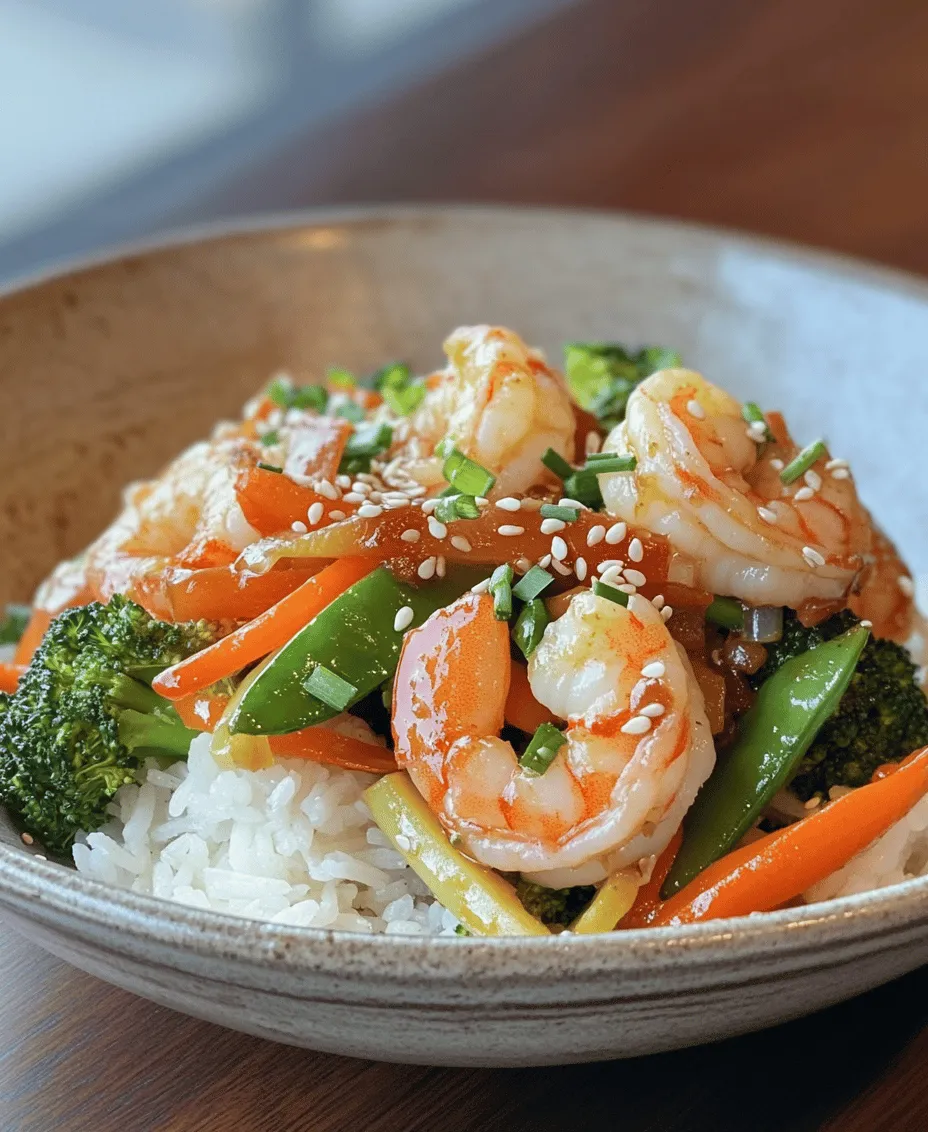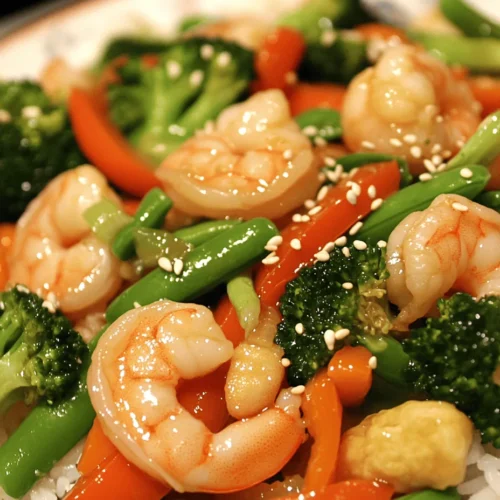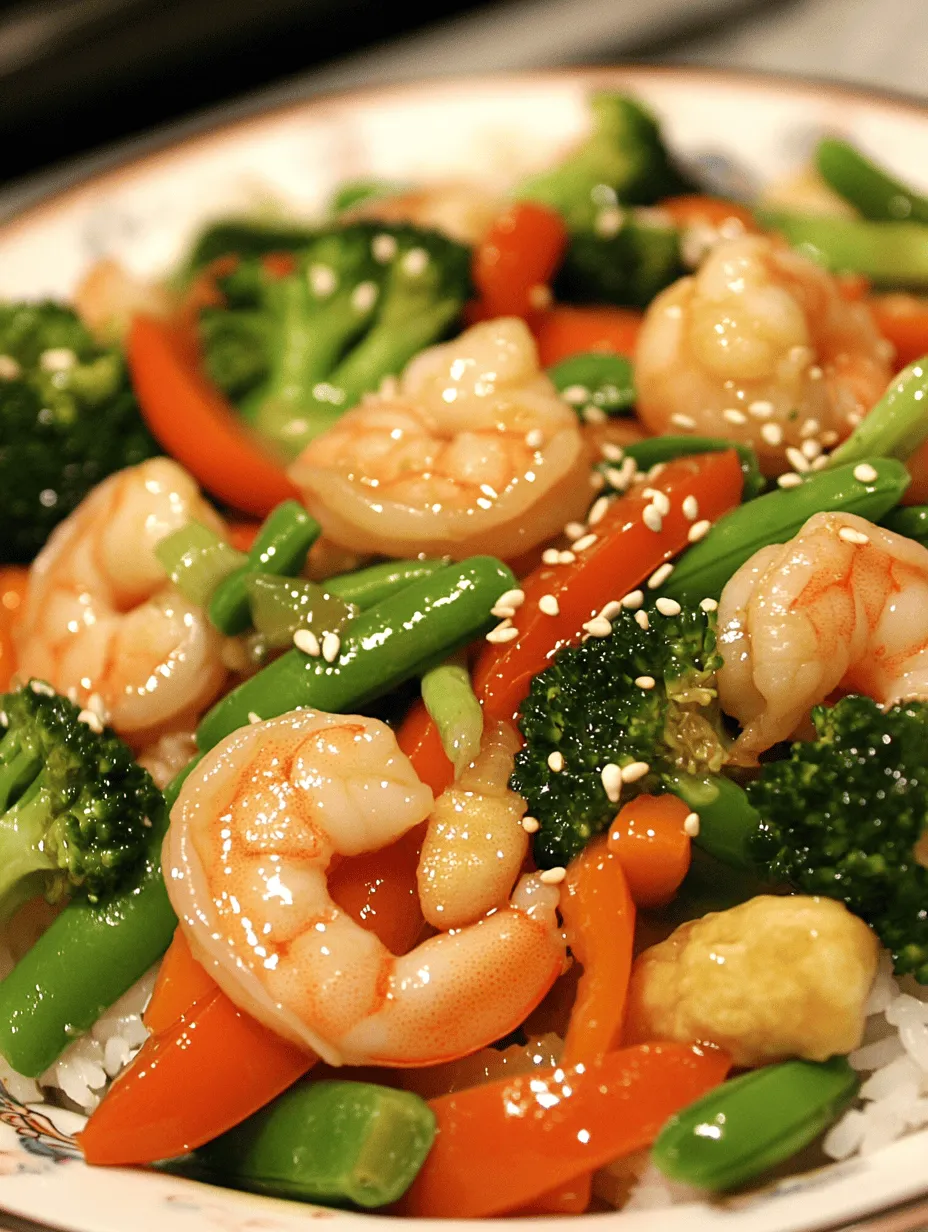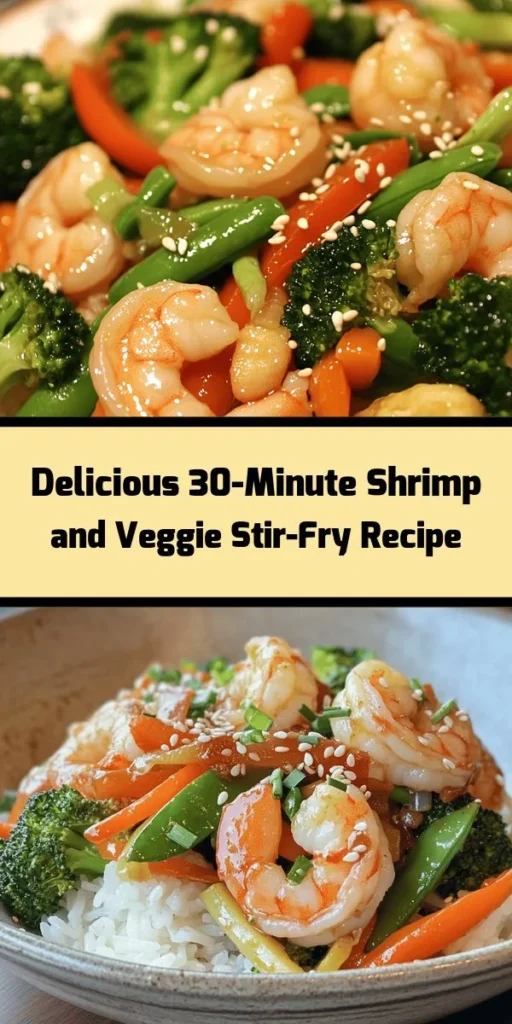Introduction
Stir-fry dishes hold a special place in the culinary world, captivating taste buds with their vibrant colors, tantalizing flavors, and satisfying textures. They are not just meals; they are a celebration of fresh ingredients and quick cooking techniques that allow for maximum flavor in minimal time. In today’s fast-paced environment, where time is often of the essence, the allure of a quick and nutritious dish is undeniable.
Our Quick & Zesty Shrimp and Veggie Stir-Fry stands out as an ideal choice for anyone looking to whip up a wholesome meal in under 30 minutes. This recipe beautifully balances succulent shrimp, packed with protein, and a medley of colorful vegetables that contribute essential vitamins and minerals. Whether you’re a busy professional, a student, or a parent juggling multiple responsibilities, this dish offers a delightful solution to mealtime dilemmas, ensuring you don’t have to sacrifice health for speed.
Understanding Stir-Fry Cooking
Definition and Origins of Stir-Frying
Stir-frying is a cooking technique that originated in China centuries ago and has since become popular worldwide. This method involves cooking food quickly over high heat while stirring continuously, which allows for even cooking and retains the food’s natural flavors and textures. Traditionally, a wok is used, which is designed to distribute heat evenly and accommodate a range of ingredients.
The beauty of stir-frying lies not only in its speed but also in the way it showcases the natural characteristics of each ingredient. The high heat cooks the food quickly, sealing in flavors and moisture while allowing the vibrant colors of vegetables to shine through. It’s a method that encourages creativity in the kitchen, inviting cooks to experiment with various ingredients and flavors.
Nutritional Benefits of Stir-Frying
One of the standout benefits of stir-frying is its ability to preserve the nutritional value of vegetables. The quick cooking time means that vitamins and minerals are less likely to break down, making stir-fried dishes a healthy option. Vegetables retain their crunch, color, and flavor, providing not just a feast for the eyes but also a boost of nutrients for the body.
Moreover, the combination of protein from shrimp and the array of vegetables creates a well-rounded meal that supports a balanced diet. Shrimp is an excellent source of lean protein, low in calories and high in essential nutrients, making it an ideal choice for health-conscious individuals. When paired with a variety of vegetables, this dish becomes a powerhouse of nutrition, contributing to overall well-being.
Versatility of Stir-Fry in Various Cuisines
Stir-frying is not limited to Asian cuisine. While it is commonly associated with Chinese dishes, this technique has been adopted and adapted in various culinary traditions around the globe. From Thai to Mexican, stir-fry can incorporate a diverse range of ingredients, flavors, and spices, allowing for endless variations. This adaptability makes it a favorite among home cooks and chefs alike, as it can cater to different dietary needs and preferences.
Whether you’re craving something spicy, sweet, or savory, stir-frying can easily accommodate your taste buds. The Quick & Zesty Shrimp and Veggie Stir-Fry is a perfect example of this versatility, bringing together Asian-inspired flavors in a dish that can be enjoyed by anyone.
Ingredients Breakdown
To create a delicious Quick & Zesty Shrimp and Veggie Stir-Fry, it’s essential to understand the main ingredients that contribute to its flavor and nutritional profile. Here’s a detailed breakdown:
Shrimp: Health Benefits and Cooking Tips
Shrimp is the star of this dish, providing a lean source of protein that is low in calories and rich in essential nutrients such as selenium, vitamin B12, and iodine. This seafood is not only delicious but also offers several health benefits, including promoting heart health and supporting brain function.
When preparing shrimp, it’s vital to ensure freshness. Look for shrimp that have a mild, briny smell and a firm texture. For this stir-fry, you’ll want to use medium or large shrimp. Always clean and devein them before cooking. To clean shrimp, rinse them under cold water and remove the shell, leaving the tail intact if desired. For deveining, make a shallow cut along the back and remove the dark vein with a toothpick or your fingers.
Mixed Vegetables: Nutritional Value and Suggested Variations
A colorful array of mixed vegetables adds not only flavor but also a plethora of nutrients to the stir-fry. Common vegetables used in stir-fries include bell peppers, broccoli, snap peas, and carrots. These vegetables are packed with vitamins A and C, potassium, and dietary fiber, making them excellent choices for promoting overall health.
Feel free to mix and match based on what you have available or prefer. Other great additions include zucchini, asparagus, bok choy, and mushrooms. The key is to ensure that the vegetables are cut into uniform sizes for even cooking. This not only enhances the dish’s appearance but also ensures that each bite is filled with a balanced taste of shrimp and veggies.
Soy Sauce and Oyster Sauce: Flavor Profiles and Alternatives
To elevate the flavors of your stir-fry, sauces play a crucial role. Soy sauce is a staple in stir-fry cooking, providing a salty, umami flavor that complements the shrimp and vegetables perfectly. It’s made from fermented soybeans and can be found in various types, including low-sodium options for those watching their salt intake.
Oyster sauce adds a rich, slightly sweet flavor that enhances the overall taste of the stir-fry. It is made from oyster extracts and is a popular choice in Asian cooking. For a vegetarian or vegan alternative, consider using mushroom sauce or a combination of soy sauce and a touch of sugar to mimic the sweetness of oyster sauce.
Sesame Oil: Importance in Asian Cuisine and Its Health Benefits
Sesame oil is another critical ingredient in this stir-fry, known for its distinctive flavor and aroma. It is derived from sesame seeds and is commonly used in Asian cuisine for its nutty taste. Beyond its culinary uses, sesame oil also boasts several health benefits, including antioxidants and anti-inflammatory properties.
When using sesame oil, consider using it as a finishing oil rather than a cooking oil due to its low smoke point. Add it to the stir-fry towards the end of the cooking process to preserve its flavor and health benefits.
Garlic and Ginger: Flavor Enhancers with Health Benefits
Garlic and ginger are essential aromatics in many Asian dishes, including our Quick & Zesty Shrimp and Veggie Stir-Fry. Both ingredients are revered for their flavor and numerous health benefits. Garlic is known for its immune-boosting properties and ability to reduce cholesterol levels, while ginger has anti-inflammatory effects and aids digestion.
To prepare garlic, simply mince or slice it, and for ginger, you can peel and either slice or grate it. Adding these ingredients to your stir-fry will enhance the dish’s overall flavor profile, creating a delicious and aromatic experience.
Importance of Using Fresh Ingredients for Optimal Taste
The foundation of any great stir-fry lies in the quality of the ingredients. Using fresh, high-quality produce not only enhances the flavor but also contributes to the overall healthiness of the meal. Whenever possible, opt for seasonal vegetables and fresh shrimp to maximize taste and nutritional value.
Incorporating fresh ingredients elevates the dish, providing a depth of flavor that frozen or canned items simply cannot replicate. Taking the time to select the best ingredients will ensure that your Quick & Zesty Shrimp and Veggie Stir-Fry is not only quick to prepare but also bursting with flavor and nutrition.
Preparation Steps Explained
Preparation is key to creating a successful stir-fry, and understanding the steps involved will help streamline your cooking process. Let’s break down the essential preparation steps:
Preparing the Shrimp: Cleaning and Deveining
Before cooking, it’s crucial to prepare the shrimp properly. Start by rinsing them under cold water to remove any debris. Next, remove the shell, leaving the tail on if desired, and make a shallow cut along the back to devein. This process may seem tedious, but taking the time to clean the shrimp ensures a more pleasant eating experience and enhances the dish’s overall quality.
Chopping Vegetables: Techniques for Uniform Sizes
While the shrimp is marinating, focus on preparing the vegetables. To achieve even cooking, chop the vegetables into uniform sizes. For example, slice bell peppers into strips, chop broccoli into bite-sized florets, and cut carrots into thin rounds. This will help ensure that all ingredients cook evenly and maintain their crispness.
The Significance of Marinating Shrimp and Veggies for Flavor Enhancement
Marinating the shrimp and vegetables is an essential step in enhancing the overall flavor of the dish. A simple marinade can be made by combining soy sauce, sesame oil, minced garlic, and ginger. Allow the shrimp and vegetables to marinate for at least 15 minutes to absorb these flavors before cooking. This step not only infuses the ingredients with deliciousness but also helps tenderize the shrimp, resulting in a more succulent texture.
Tips for Efficient Preparation: Mise en Place
To make the cooking process as seamless as possible, practice mise en place, which means “everything in its place.” Before you start cooking, gather and prepare all your ingredients. This includes chopping vegetables, measuring out sauces, and having your cooking utensils ready. By doing so, you’ll create an organized workspace, making the stir-frying process quick and efficient. This preparation method allows you to focus on cooking rather than scrambling to find ingredients or tools during the cooking process.
By following these steps, you’ll set the stage for a delightful cooking experience that culminates in a delicious Quick & Zesty Shrimp and Veggie Stir-Fry. The combination of fresh ingredients, healthy cooking methods, and vibrant flavors promises a dish that is sure to impress both you and your guests. Get ready to savor the delightful balance of protein and vegetables that this stir-fry has to offer!

Cooking Techniques
Heating the Pan: Understanding Temperature Control in Stir-Frying
The foundation of a great stir-fry begins with the right temperature. Preheat your wok or skillet until it is hot—almost smoking. This high heat is crucial for achieving that signature sear on the shrimp and crispiness in the vegetables. If the pan is not hot enough, your ingredients will steam instead of fry, resulting in a less desirable texture. A well-heated pan enables quick cooking, locking in flavors and nutrients while maintaining a vibrant color in the veggies.
When using oil, choose one with a high smoke point, such as canola or peanut oil. This will help prevent burning and ensure that your stir-fry comes together seamlessly. Once the oil shimmers, you know it’s ready for adding the shrimp.
Cooking Shrimp Perfectly: Importance of Timing and Visual Cues
Cooking shrimp requires precision. Overcooked shrimp can become rubbery, so timing is everything. When you add the shrimp to the hot pan, they should immediately start to turn pink and opaque. This typically takes about 2-3 minutes on each side, depending on their size.
A visual cue to look for is the shape of the shrimp. Perfectly cooked shrimp will curl into a C-shape, while overcooked shrimp will form an O shape. As soon as they reach that ideal hue and texture, remove them from the pan and set them aside. This allows you to sauté the vegetables without the shrimp becoming overdone.
Sautéing Vegetables: Achieving the Perfect Texture
Vegetables in a stir-fry should be crisp-tender, meaning they retain some crunch while being cooked through. To achieve this, consider the cooking times of each vegetable. Start with harder vegetables like broccoli and bell peppers, which take longer to cook. Sauté these first for about 3-4 minutes before adding softer vegetables like snap peas or carrots, which only need about 2 minutes.
Keep the vegetables moving in the pan to avoid burning and ensure even cooking. A splash of water or broth can help create steam, which speeds up cooking while keeping the veggies vibrant and colorful.
Combining Ingredients: How to Layer Flavors Effectively
Once your shrimp and vegetables are cooked, it’s time to combine them. Return the shrimp to the pan, and pour in your sauce mixture. Stir everything together quickly to ensure an even coating. The key to layering flavors is to add ingredients in stages, allowing each component to contribute its essence to the final dish.
For example, add aromatics like garlic and ginger early in the cooking process to infuse the oil, and incorporate sauces or seasonings towards the end. This method allows the flavors to meld beautifully, creating a dish that is both complex and satisfying.
The Role of Cornstarch Slurry in Thickening Sauces and Enhancing Texture
To achieve that glossy restaurant-style finish, a cornstarch slurry is your best friend. Mix equal parts cornstarch and cold water in a small bowl, then add it to your stir-fry during the final minute of cooking. The heat will activate the cornstarch, thickening the sauce and ensuring it clings to the shrimp and vegetables.
This technique not only enhances the texture of your dish but also adds a beautiful sheen, making your stir-fry visually appealing. Just be careful not to add too much slurry; a little goes a long way!
Serving Suggestions
Choosing the Right Base: Rice vs. Noodles
When serving your Quick & Zesty Shrimp and Veggie Stir-Fry, the base you choose can elevate the meal. Traditional options include rice and noodles. Steamed jasmine or brown rice is a popular choice, providing a fluffy backdrop that soaks up the sauce beautifully.
For a different twist, consider using stir-fried noodles like udon or rice noodles. They add a chewy texture that complements the tender shrimp and crisp vegetables. If you want a low-carb option, cauliflower rice is an excellent substitute that offers a similar texture with fewer calories.
Creative Presentation Ideas: Enhancing Visual Appeal
Presentation can make a significant impact on how a dish is perceived. To elevate your stir-fry, consider serving it in a shallow bowl or on a large platter. Arrange the shrimp and vegetables artfully, creating a colorful display that highlights the freshness of the ingredients.
For an added touch, serve the dish alongside lime wedges or a sprinkle of chopped herbs, like cilantro or parsley, which will enhance the visual appeal and aroma of the dish.
Garnishing Tips: Using Sesame Seeds and Green Onions for Added Flavor and Aesthetics
Garnishing your stir-fry not only enhances its look but also adds layers of flavor. A sprinkle of toasted sesame seeds brings a nutty crunch that complements the shrimp perfectly.
Chopped green onions add a fresh, oniony bite that contrasts nicely with the savory flavors of the stir-fry. For an extra pop of color, consider adding thin slices of red chili or a drizzle of chili oil for those who appreciate a little heat.
Nutritional Analysis
Caloric Breakdown Per Serving
This Quick & Zesty Shrimp and Veggie Stir-Fry is not only delicious but also a nutritious choice. On average, one serving (approximately 1.5 cups) contains around 300-350 calories. This calorie count can vary based on the specific ingredients used, such as the amount of oil and type of rice or noodles.
Nutritional Benefits of the Dish: Protein Content, Vitamins from Veggies
Shrimp is a lean protein source, providing about 20-25 grams of protein per serving, essential for muscle maintenance and repair. The variety of vegetables included in this stir-fry contributes vital vitamins and minerals. For instance, broccoli is rich in vitamin C and K, bell peppers provide vitamin A, and snap peas offer a healthy dose of fiber.
This dish is well-balanced, offering a good mix of protein, healthy fats, and carbohydrates, making it a perfect choice for a nutritious meal.
Customizing for Dietary Needs: Low-Sodium Options, Gluten-Free Variations
For those watching their sodium intake, consider using low-sodium soy sauce or tamari. This will help maintain flavor without compromising health. If you need a gluten-free option, ensure that the soy sauce is gluten-free, or substitute with coconut aminos, which offers a similar taste profile.
Additionally, you can customize the vegetables based on seasonal availability or personal preferences. Options like zucchini, asparagus, or bell peppers can easily replace traditional choices while maintaining the dish’s integrity.
Cultural Significance of Stir-Fry in Different Cuisines
Overview of Stir-Fry in Asian Cuisine
Stir-frying is a staple cooking method in many Asian cuisines, particularly in Chinese and Thai culinary traditions. This technique allows for quick cooking at high temperatures, preserving the nutritional value of ingredients while infusing them with rich flavors. The method emphasizes balance, combining proteins, vegetables, and sauces in perfect harmony.
Comparisons with Other Cooking Methods: Sautéing vs. Steaming
While sautéing and steaming are both popular cooking methods, they yield different results. Sautéing, as seen in stir-frying, allows for browning and caramelization, which enhances flavor. In contrast, steaming preserves texture and nutrients but does not develop the same depth of flavor.
The versatility of stir-frying makes it a go-to method for busy home cooks looking to create quick, delicious meals while maximizing the health benefits of their ingredients.
How Stir-Fry Has Been Adapted Globally
Stir-fry has transcended its Asian origins, becoming a beloved cooking technique worldwide. In Western cuisines, stir-frying has been adapted to incorporate local ingredients, spices, and flavor profiles. Many chefs and home cooks enjoy experimenting with various proteins, such as chicken, beef, or tofu, and a wide range of vegetables, making stir-frying a universal favorite.
This adaptability highlights the dish’s potential to cater to diverse palates while maintaining its quick and healthy essence.
Conclusion
In summary, this Quick & Zesty Shrimp and Veggie Stir-Fry represents a perfect balance of flavor, nutrition, and convenience. With its vibrant colors and enticing aromas, it serves as a reminder that healthy meals can be delicious and satisfying.
We encourage you to experiment with different vegetables, proteins, and sauces, allowing your creativity to shine in the kitchen. Whether you’re preparing a weeknight dinner or impressing guests, this stir-fry is a quick and nutritious option that can easily become a staple in your meal rotation.
Embrace the ease and health benefits of quick cooking techniques like stir-frying, making them a regular part of your culinary adventures. You’ll discover that preparing nutritious meals at home can be both fun and fulfilling.



